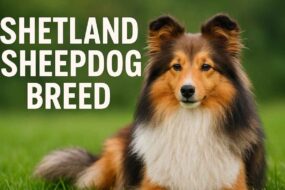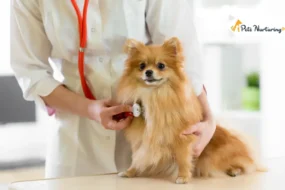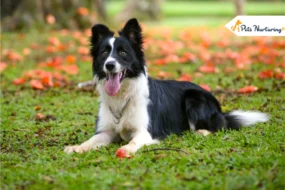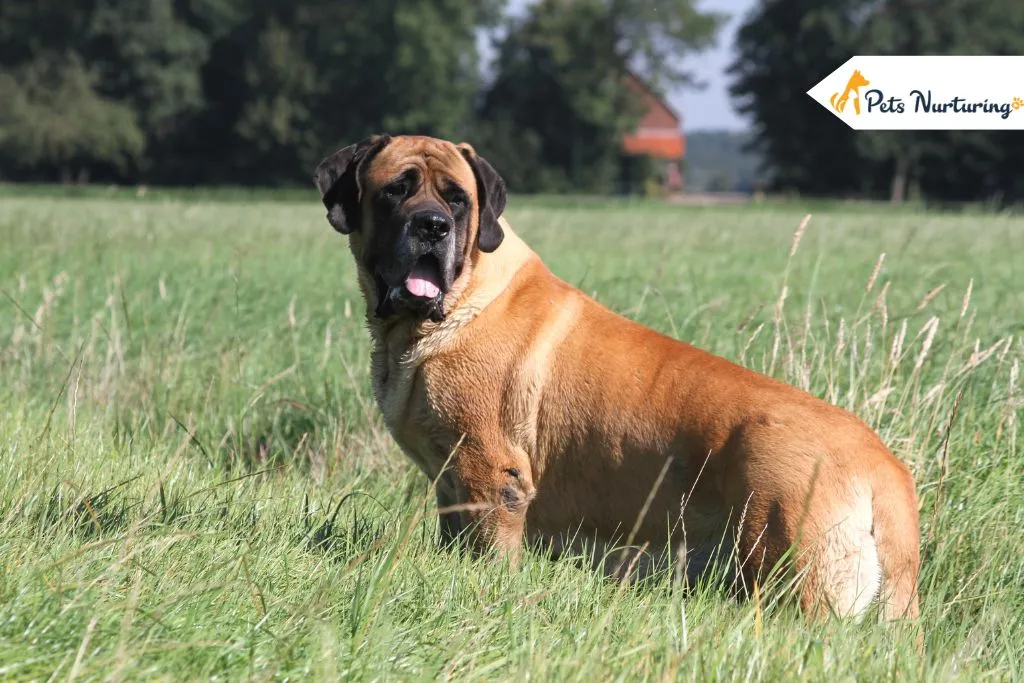
When it comes to Mastiffs, it is easy to get confused as there are different breeds of the same name – French Mastiff, Italian Mastiff, English Bull Mastiff, etc. Today, we are going to talk about the English Mastiff. The three words to describe this breed are – calm, affectionate, and courageous! If you are looking for these three qualities in a dog, English Mastiff is the right choice.
Before bringing this dog home, you need to know more about their breed, characteristics, temperament, and more. To help you become the best pet parent, we have created this complete English Mastiff breed guide.
After reading this article, you’ll know everything about this massive dog breed.
English Mastiff Dog Overview
Breed Group: Working Group
Height: 27.5 to 33 inches (at the shoulder)
Weight: 160 to 230 pounds (males), 120 to 170 pounds (females)
Lifespan: 6 to 12 years
Coat: Short, dense, and straight
Color: Fawn, apricot, or brindle
Temperament: Gentle, affectionate, protective
Needs for Grooming: Low to moderate
Hypoallergenic: No
Origin: England
History and Origin
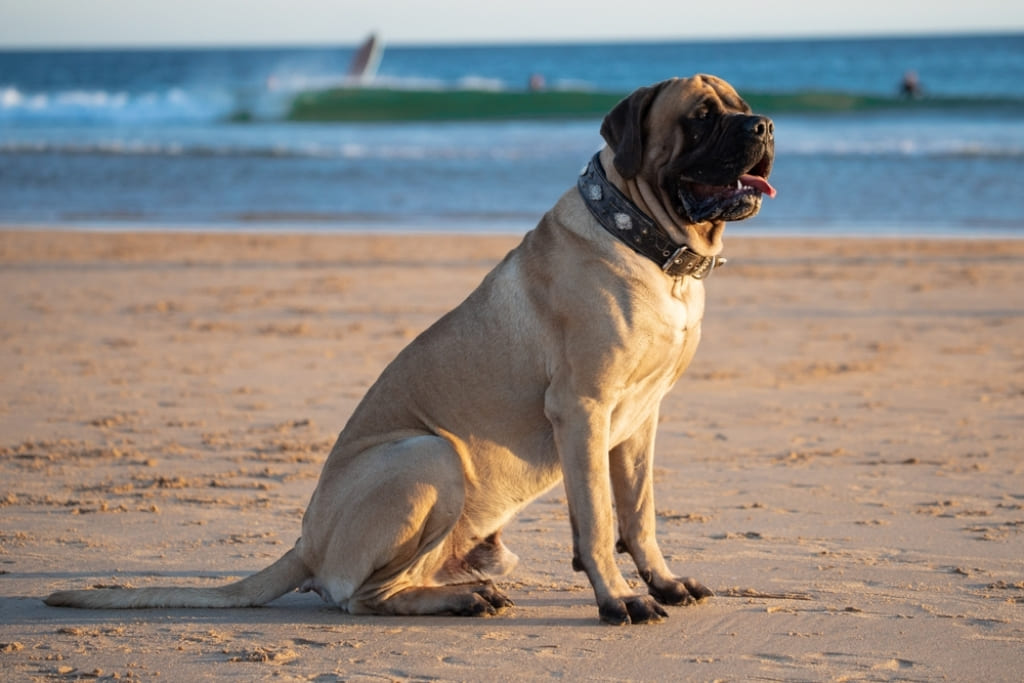
The Mastiff breed has a long history. Around 2200 BCE, during the Babylonian era, there were depictions of dogs resembling Mastiffs. They were believed to be descendants of Tibetan Mastiffs.
The English Mastiff comes from the Molossus, an old breed of dog known for being strong and quick in battle. Mastiffs were already there when the Romans came. They may have come from old dog traders.
The Romans were amazed by how brave and strong they were, so they brought some Mastiffs back to Rome. They were used to fight gladiators, bulls, bears, and other dangerous opponents.
Mastiffs were still nice dogs even after the Roman Empire ended. They were later used for fights in the pit against big, tough opponents during the Elizabethan era. But when buggering bulls and bears became illegal in 1835, the Mastiff lost its appeal and might have died out.
That same year, there were 63 Mastiffs at an English show, but there were none the next year. Wars in the 20th century also hurt the breed. By 1945, Britain had only eight Mastiffs that were old enough to breed.
The breed did make a comeback in its home country, though, thanks to a pair of good pups given by a Canadian farm. The English Mastiff may have originated in the US during the colonial era.
There are those who believe that the Mayflower brought at least one Mastiff to America. The first dog of this kind received official recognition from the American Kennel Club in 1885.
Size and Appearance
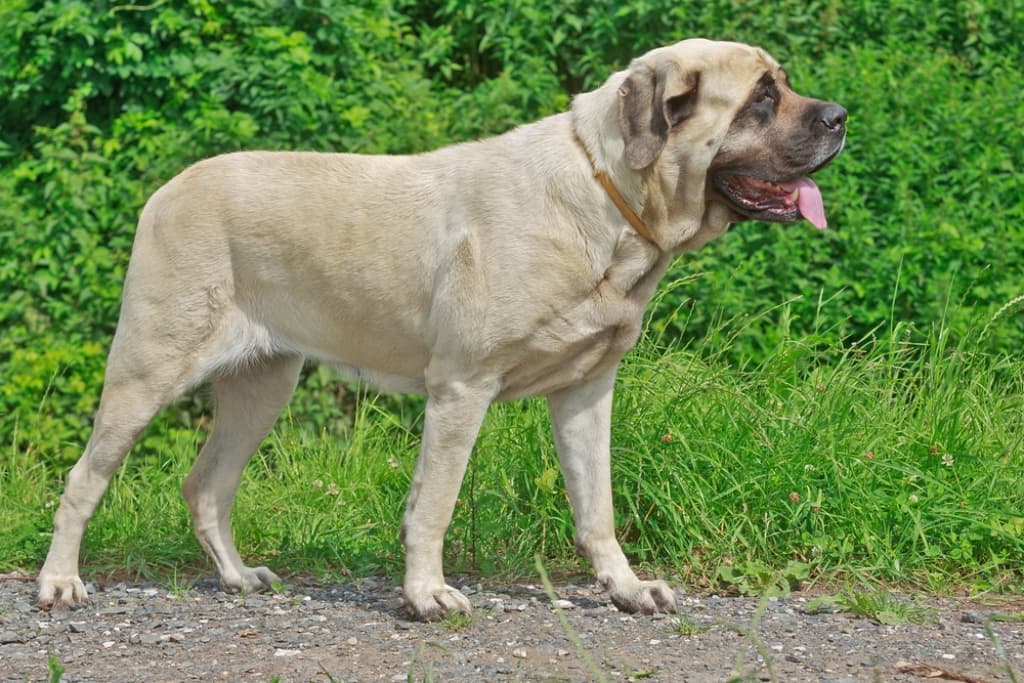
It is well known that English Mastiffs are large dogs. It is one of the biggest dog breeds in the world. They belong to the giant dog breed category. The sizes of this breed of dog are as follows:
| Gender | Height at Shoulder | Weight |
|---|---|---|
| Male | 30 inches | 160 to 230 lbs |
| Female | 27.5 inches | 120 to 170 lbs |
Mastiffs have a very strong physique with a large head. Their necks are thick and taper to the shoulders. Moreover, their legs are strong and have lots of muscles. Their paws are round and big with black nails.
The head of an English Mastiff is huge and square-shaped, with ears that fall down on either side in a V form. Their black mask, which conceals their face and short muzzle, is one of its distinguishing characteristics. Their expressions are soft and endearing because of the numerous creases on their foreheads.
Coat and Color
The English Mastiff has a double coat. It includes a rough and straight topcoat and a thick, short undercoat that lies flat against the skin.
These dogs shed their fur about twice a year, generally in fall and spring, and are considered average shedders. Regular brushing can help control their shedding.
English Mastiffs come in various coat colors:
1. Fawn
This is a pale yellowish tan color, leaning more towards tan than yellow.
2. Apricot
Their coat is a faint yellowish-orangish tint, relatively lighter than the dried fruit it’s called after.
3. Brindle
Some Mastiffs have slight tiger-like streaking with uneven stripes that are darker than the base apricot or fawn coat.
Some dogs may have a little white spot on their bodies. But it’s important to know that the American Kennel Club thinks it’s a flaw if their hair has too much white on it, especially in places different than the chest.
Characteristics and Temperament
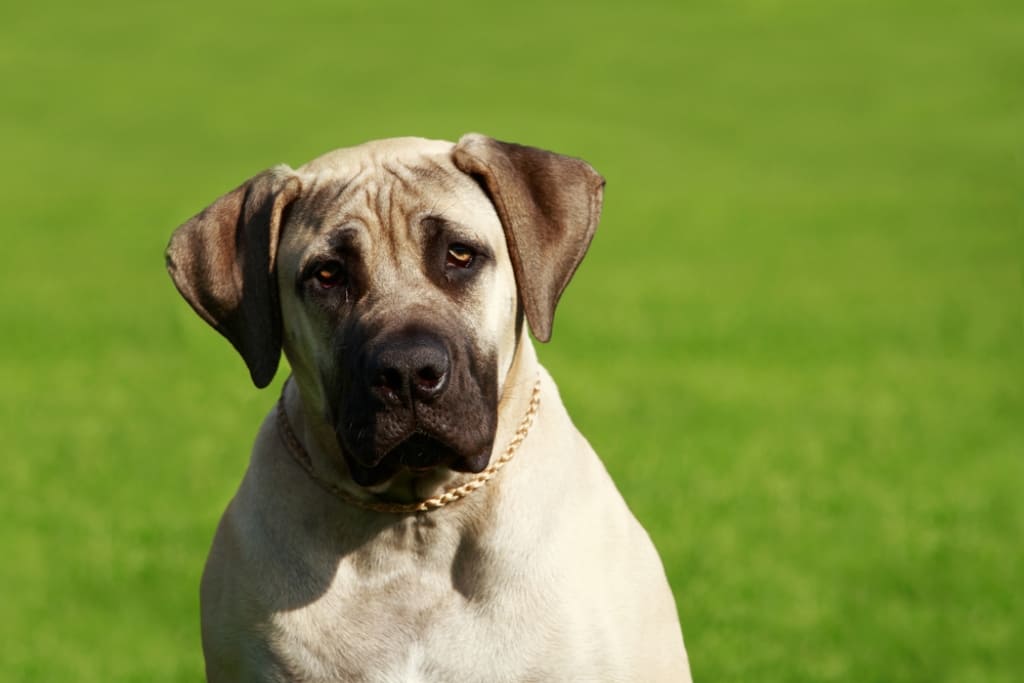
Mastiffs are big dogs, but they’re really big softies at heart. People call them “gentle giants” because they are known for being calm, kind, and good with kids. Here are some unique characteristics of this dog.
| Energy level | Medium |
| Friendliness | High |
| Affection | High |
| Shedding amount | Medium |
| Smartness | Low |
| Friendly with kids | High |
| Friendly with pets | Low |
| Need for exercise | High |
| Playful behavior | High |
| Barking habits | Low |
| Trainability | Low |
English Mastiffs are very friendly dogs. They often sit near to you in the hopes of receiving a head pat and adore giving extended embraces. You can give your Mastiff belly rubs and ear scratches to let them know you appreciate them as their owner. They respond well to human love, which makes it a good way to train and reinforce their obedience.
Because they like being cozy, these big dogs might try to get on your furniture. If they don’t learn not to do this, you should be ready for damage to your seat.
The best thing for English Mastiffs is to spend the whole day with their family. It would be great if you could bring the dog with you. They’re great as “shop dogs” or office dogs because they’re happy to spend most of the day relaxing and enjoying human company.
Your Mastiff will also enjoy being in the yard in the afternoons and watching the kids play. Even though they don’t get too excited when little hands poke them, they’re calm and don’t mind playing with the kids. They won’t do well, though, if you leave them alone in the yard for long amounts of time.
Mastiffs need to be around people all the time, as they can suffer from separation anxiety. They aren’t as good as outdoor guard dogs because they might get too sad to protect the land well. This breed is also not good for people who are away from home for long amounts of time. Because of this, Mastiffs make great family dogs because there’s always someone to cuddle with them.
Genetics, training, and socialization are just some of the things that can change their character. A puppy with a good temperament is usually playful and curious, and it loves to be held and connect with people. It’s best to get a puppy with an attitude that’s somewhere in the middle. You don’t want one that is too aggressive with other puppies or too shy.
Socializing your Mastiff is very important if you want it to be a well-adjusted and healthy adult dog. A great way to start this process is to sign them up for puppy school. Having people over often, taking your dog to busy places, shops that allow dogs, and long walks to meet neighbors can all help them improve their social skills.
- Very loyal
- Needs medium exercise
- Good with children
- Will protect family
- Enjoys cool weather
- Not a flight risk
- Very loving
- Destructive when anxious
- Dislikes being alone
- Large and clumsy
- May snore and fart
- Overheats quickly in summer
- Prone to health issues
- Slobbers a lot
Health and Nutrition
In their first eighteen months, English Mastiffs grow very quickly. Because of this, it is very important to give them the right food and care during this time. It’s impossible to make up for not giving English Mastiff puppies the right food in their first few months.
Knowing the right way to feed your English Mastiff puppies is an important part of being a caring pet owner.
Because Mastiff dogs grow so quickly, here are some tips on how to feed them:
| Age (weeks) | Daily Food Amount (cups) | Meals per Day |
|---|---|---|
| 4-8 weeks | 3-4 | 3-4 |
| 8-12 weeks | 4-6 | 3-4 |
| 12-16 weeks | 6-8 | 3-4 |
| 4-6 months | 8-10 | 2-3 |
| 6-18 months | 8-12 | 2-3 |
When it comes to food, English Mastiffs do best on meat. For pups, a diet with about 25 to 27 percent protein and 12 to 15 percent fat is best. Puppy muscles grow quickly in the early stages, so they need more protein than adult muscles.
As your Mastiff gets older, their food should have about 22–25% protein and 8–10% fat. If you feed older Mastiffs food with more than 21% protein, it can cause health problems like kidney and liver failure.
In order to lower their risk of hip dysplasia, you must also add Vitamin C to their food. If you give your pet too much calcium, it can throw off their pH balance and possibly cause problems with their bones.
Common Health Problems
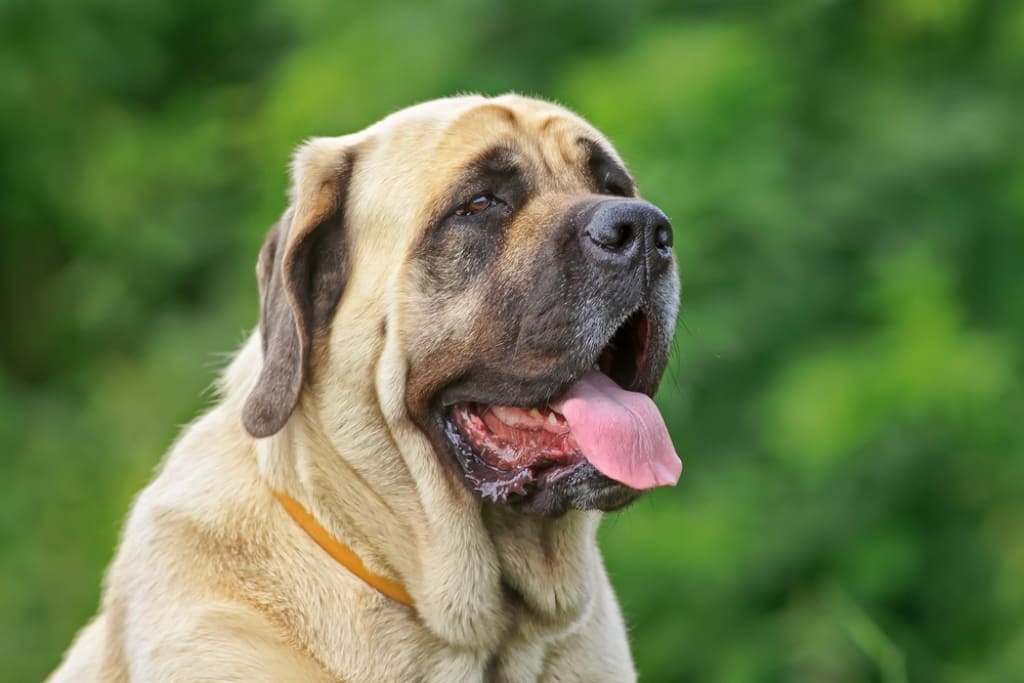
Mastiffs and other giant-breed dogs tend to live shorter lives, between 6 and 12 years. Responsible breeders check for common health problems that affect the Mastiff breed to make sure their kids are healthy.
Pet insurance can be a good idea for Mastiff owners because the breed is prone to a number of health problems.
1. Allergies
Mastiffs can have seasonal allergies, just like humans, cats, and dogs. Pollen, dust, mold, and bug bites can all cause these allergies. These allergies can make skin itch, give ear infections, red eyes, a runny nose, or make them sneeze.
Diagnoses of seasonal allergies are generally based on symptoms, physical exams, and how well treatment works. In severe cases, a veterinary dermatologist may need to test for allergies and treat the pet specifically.
2. Hip Dysplasia
Hip dysplasia happens when the bones in the hip joint don’t line up properly. This lets the joint wear out and lose its ability to do its job over time. It may run in the family, but activity, weight, and food choices can also affect it. You can check for hip dysplasia with X-rays, and the way you treat it depends on how bad it is.
3. Eye Problems
Ectropion, entropion, cataracts, and progressive macular degeneration are some of the eye problems that mastiffs can get. Genetic testing is the only way to check for progressive retinal atrophy.
4. Degenerative Myelopathy
This spinal cord disease gets worse over time and makes the back legs weak or paralyzed. The exact reason for it is unknown, but some dogs with a genetic change are more likely to get it.
Signs include hind-end weakness, stumbling, and, eventually, the inability to use the hind legs. Unfortunately, there’s no cure, but diet, exercise, and physical therapy can help maintain muscle mass and quality of life.
5. Epilepsy
Epilepsy involves recurrent seizures with various symptoms. Treatment typically involves anticonvulsants, allowing most pets to lead a relatively normal life.
6. Gastric Dilatation and Volvulus (GDV)
This is a very bad kind of bloat that can happen to dogs with deep chests like the Mastiff. It happens when the stomach gets full of food and gas, which makes it swell and block blood flow and breathing, which could cause it to burst.
Surgery to prevent GDV and eating several smaller meals each day can help lower the risk. If your Mastiff has a swollen belly or retching that doesn’t produce anything, you should take them to the vet right away.
7. Cancer
Cancers like osteosarcoma, lymphoma, hemangiosarcoma, and mast cell tumors can happen to mastiffs. Dogs with these cancers may limp, have growths on their skin, or act in other strange ways. A doctor should check out any Mastiff that shows these symptoms.
Behavior and Training
Mastiffs are calm and patient at home, but they act quickly if they think they are in danger. Because they are gentle, they make great pets for families with kids who know how to treat dogs.
They might not be the best choice for homes with very young children, though, because these big dogs could accidentally bump into them. Generally speaking, mastiffs are large, amiable dogs that get along well with other animals, particularly when they first encounter them as puppies.
Mastiffs may be cautious around strangers since they have spent hundreds of years serving as guard dogs. Early socialization and training are necessary for mastiff puppies to help them adjust to new situations and people. Despite being shy, mastiffs don’t bark around people and other animals.
Mastiffs are rapid learners who want to please their owners and learn well with positive reinforcement and fun. However, brief training sessions help them focus and stay on course.
Mastiffs need socialization and training like other dogs. Their size makes this more important. Watch carefully for leash-pulling and jumping. Socializing them may help them regulate their protective tendencies and avoid overprotection when guests arrive.
Exercise Needs
Mastiffs are huge dogs, but they don’t need much exercise. They usually need an hour of daily exercise. You can split this time into interesting activities and play with them.
These dogs are very calm and don’t do well with rigorous exercise. A simple walk and playing fetch is enough for them. However, make sure you offer them proper mental stimulation.
Buy interactive games for them and spend time, or else they will get bored. These dogs may become anxious if you don’t spend time with them, so remember to keep them engaged.
Grooming Needs
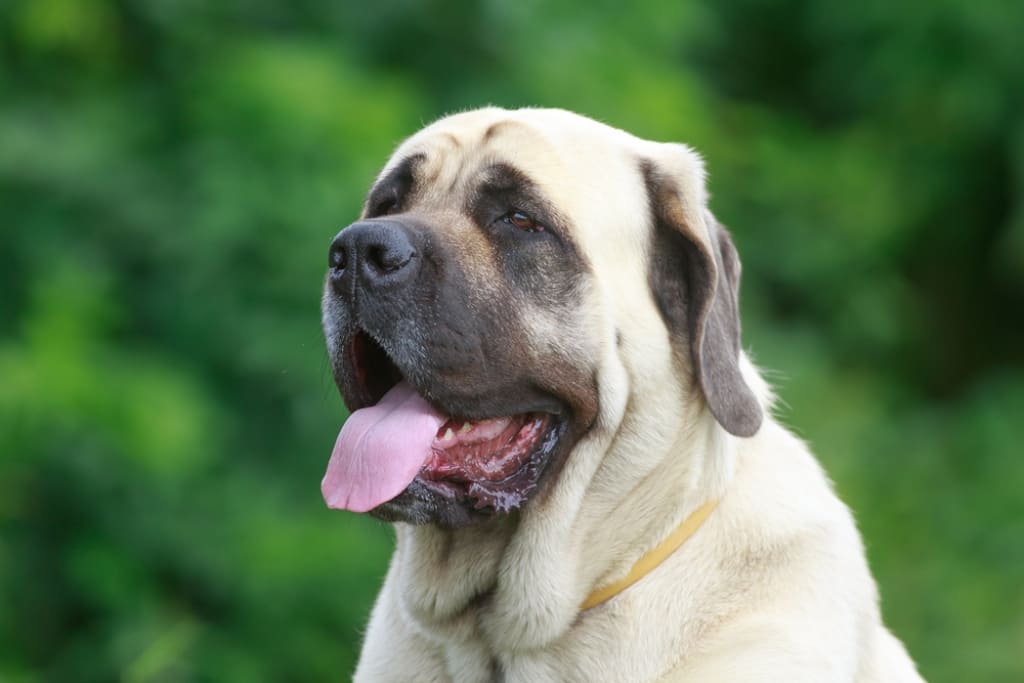
English Mastiffs need proper grooming from time to time. They have short hair and don’t need much grooming in that area. The only thing you have to worry about is their drool. These dogs drool a lot, and it can be a hassle for some people.
They have sagging cheeks, which makes it difficult to clean their drool. You can keep a cloth handy to wipe their face from time to time. If you don’t do so, they will drool all over your furniture and floor.
You also need to clean their facial fold to avoid any skin infection. Mastiffs have folded skin, which can easily accumulate dirt and dust. You need to wipe their face carefully with wipes to keep it clean.
Mastiffs have short coats, and they shed moderately. You need to brush their coat to keep it clean and neat. During the shedding season, you need to brush their coat more often. Apart from that, you also need to bathe them every few months.
These dogs are susceptible to a number of eye disorders, so it’s important to look for signs of infection. Frequent cleaning of a Mastiff’s eyes is essential to preventing infections and tear stains.
Using a veterinarian-approved ear cleanser on a regular basis is crucial to keeping your Mastiff’s ear canals in good condition. When they come from anything that involves water, such as a bath or a swim, you should clean their ears.
Are English Mastiffs Hypoallergenic?
Getting a Mastiff is not a good option if you have allergies to dog hair because Mastiffs are not hypoallergenic canines. They might aggravate your allergies to the point that it’s hard for them to coexist with you.
It’s true that no breed is completely hypoallergenic, but mastiffs are definitely not. Despite what their short coat might lead you to believe, this animal sheds.
It may not seem like much, but Mastiffs and other short-haired breeds can shed a lot. Mastiffs shed more because they have thick, short fur due to having two coats.
During their shedding seasons in the spring and fall, they shed considerably more. Thus, depending on the season, mastiffs might shed anywhere from a small amount to a lot.
Price
The cost of an English Mastiff can vary significantly based on a number of factors, including the breeder’s name, the dog’s age, health, and lineage. English Mastiff puppies for sale that are suitable for showing will cost extra.
Adoption typically costs between $50 and $150. Locating a Mastiff for free or through an animal rescue might be challenging. Try to find out as much as you can about their past if you do find one in a rescue, especially if they’re older.
Purchasing a purebred Mastiff from a breeder will set you back between $1,000 and $3,500. You should thoroughly investigate the breeder to make sure your new puppy is healthy and free of serious medical issues. This entails speaking with prior clients and obtaining both parents’ complete medical histories.
Upon bringing your Mastiff home, you will have to purchase supplies and set it up, which will run you between $600 and $850. This comprises all the essentials for caring for your recently acquired canine. Remember that Mastiffs are larger dogs, so you might need to purchase additional items for them.
Life Span
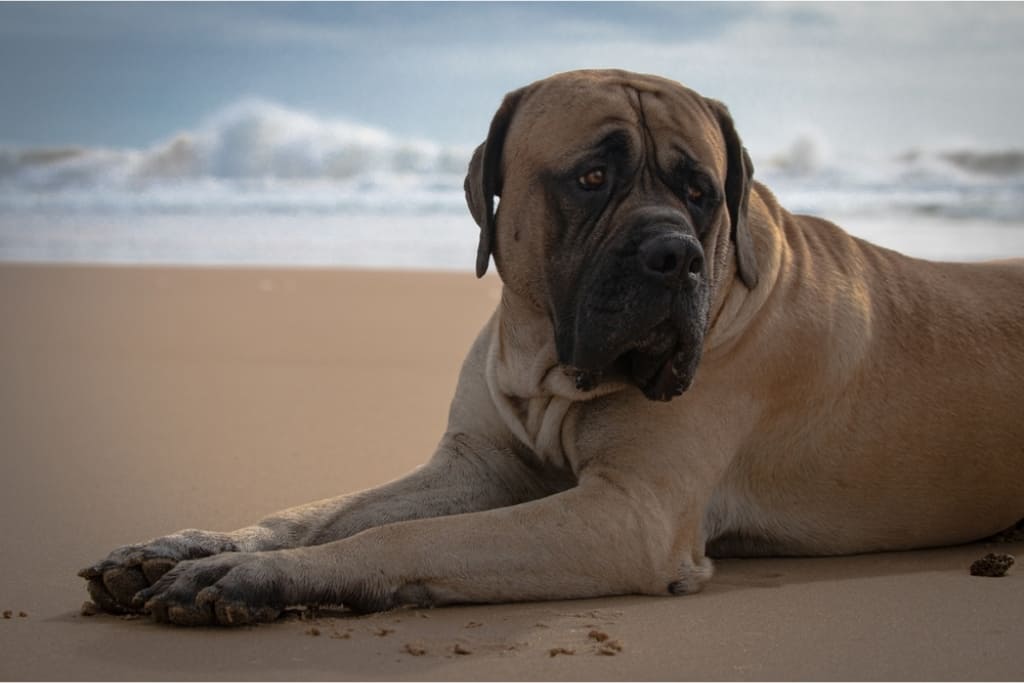
Mastiffs often live six to twelve years. Your Mastiff’s greatest chance of death is from cancer or old age if they are not ill or injured. Regrettably, many large and massive breeds suffer from illnesses that cause them to pass away at a relatively young age.
One of the most significant factors influencing a dog’s lifespan is its size. As a general rule, bigger breeds tend to live less long. The main reason for this is that bigger dogs tend to age faster and show signs of getting older much earlier than smaller dogs.
Giant breeds like Mastiffs are considered senior dogs when they reach the age of six. On the other hand, small dogs can still be active and young at 12 years or older.
FAQs
The English Mastiff is the world’s largest dog and can weigh up to 200 pounds.
English Mastiffs are 110 pounds heavier than a wolf.
Mastiffs often get anxious when left alone and may act out destructively.
Conclusion
Now you know everything about the huge English Mastiff dog breed. People who train and socialize these big dogs properly can make them great pets. They will watch over your house and keep your family safe. They can have a lot of health problems, so make sure you buy them from a breeder you can trust. Check the health papers, too, to make sure they are healthy.
In Case you Missed it:








